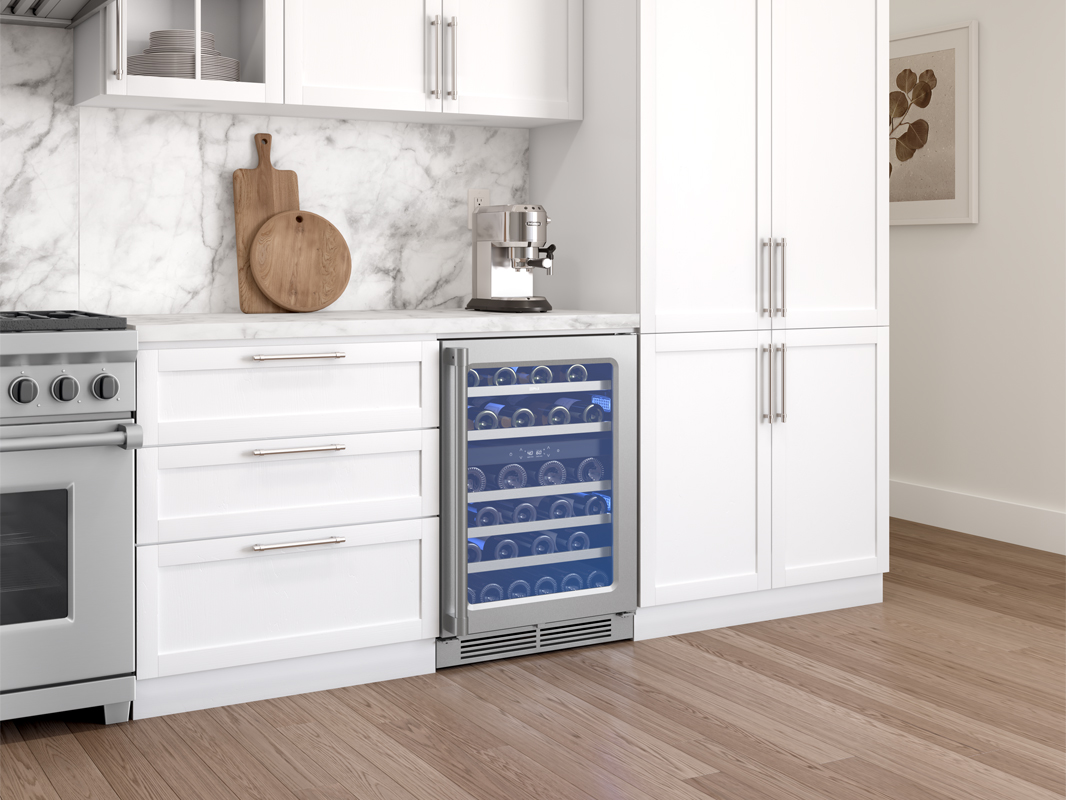7 Wine Fridge and Storage Basics You Need to Know
If you're a wine lover like us, you probably collect bottles from various tastings, trips, or special events. You've also likely heard that while some wines are best enjoyed right away, others improve with age. First,

7 wine fridge and storage basics you need to know
1. Temperature control
Among all the factors that affect wine quality, temperature control is perhaps the most crucial. If the temperature is too warm or too cold, it can quickly spoil your wine. Ideally, wine should be stored at around 55ºF (13ºC), though this can vary depending on the type of wine you’re storing. Temperature fluctuations can be harmful, so keep the storage temperature as stable as possible. Fluctuations can cause the cork to expand and contract, which might let the oxygen to seep in, ultimately negatively affecting the wine.
- Red wines: should be served slightly cooler than room temperature, between 55 and 60°F (13-16°C). The exact temperature depends on the wine’s age, with older and more tannic reds are best served at 61-65°F (16-18°C) and younger reds on the cooler end.
- White wines: on the other hand, should be served colder than reds but not so cold that it dampens the aromas. The ideal serving temperature for whites is between 45-55°F (7-12°C).
- Sparkling and sweet white wines: should be on the colder end, while Champagne should be served the coldest, between 41-47°F (5-8°C).
The key takeaway is to keep your wine storage temperature consistent to protect the quality of your collection. Minor fluctuations won’t do much harm, but large swings ultimately will. Keeping the temperature steady is one of the most important steps if you want to preserve your wine’s best qualities. Wine fridges with adjustable temperature settings will keep your wines under right conditions.
2. Humidity levels
Managing humidity in your wine storage area is another important step for preserving your wine’s quality. For optimal wine storage, aim to keep the humidity level between 60% and 70%. This range helps prevent corks from drying out while also avoiding the risks associated with excessive moisture. If you plan to age wine for several years, maintaining consistent humidity becomes even more important. Laying bottles on their sides can help keep the corks moist for shorter-term storage, but for longer periods, you’ll need to monitor and control the humidity.
3. Keep it dark
Whether you’re storing wine for a few days, weeks, or even months, it’s important to keep it in the dark as much as possible. Direct sunlight, especially UV light, can cause your wine to age too quickly and develop off-flavors. Thats why your wine fridges have dim lighting and need to be kept away from harmful UV rays.
4. Store bottles horizontally
If your wine bottles have corks, it’s important to store them horizontally in a wine rack. Keeping wine on its side helps keep the cork moist, which is important if you plan long-term storage. Even though screw-top bottles don’t require horizontal storage, it’s still a great way to organize your collection. Storing bottles horizontally maximizes space and makes it easy to access the desired bottle when you need it.
5. Avoid vibrations
It’s important to store your wine in a spot that’s free from vibrations. Vibrations can speed up chemical reactions in the wine, shake up the sediments in the bottle, especially in vintage ones. The mentioned can interfere the aging process and affect the flavor. To keep your wine in the best condition, choose a stable location where it won’t be disturbed. Keep it away from anything that causes vibrations, like your washer, dryer, exercise equipment, or even a stereo system.
That said, if you’re only storing wine for a short time, vibrations aren’t something to worry about too much. But for long-term storage, it’s best to keep your wine still and undisturbed.
6. Store wine in a wine fridge, not standard refrigerator
A wine fridge (or wine cooler) is the best choice when it comes to proper wine storage and preservation. Unlike a standard refrigerator that keeps food in a cold and dry, a wine fridge maintains the ideal temperature for wine and the proper humidity level. Storing wine in a wine fridge prevents cross-contamination from food odors, helping to preserve the wine’s quality without affecting its taste. If you’re concerned about cost, remember that wine can be a significant investment, and a good wine fridge helps protect that investment.
7. Maintaining a wine fridge
For wine enthusiasts, a wine fridge is a practical and essential solution for proper storage. You can choose from single-zone, dual-zone, or multi-zone models depending on your needs. They come in various sizes and capacities to fit different collections.
It’s important to remember that, like any other appliance, wine fridges require regular maintenance to keep them running smoothly for years to come. To help you out, our experts have put together tips on how to properly stock your wine fridge and maintain it so that it continues to serve your wine collection effectively.
Regular upkeep is essential to prevent common issues like temperature fluctuations, clogged filters, malfunctioning fans, mold growth, and inefficient cooling. With a little care, your wine fridge will stay in top shape.
Conclusion
Wine is best enjoyed on any occasion, but it needs proper storage to retain its quality for as long as possible. For beginners at wine keeping, it’s worth knowing how to easily store away wine in the most convenient of ways. In conclusion, understanding the basics of wine storage is paramount to preserving your collection. By following these simple guidelines, you can ensure that your wines are stored safely when it’s time to uncork and savor them.
P.S. If you’re looking for more tips on wine fridges, be sure to check out our article on how to choose the right wine fridge. It’s packed with useful information to help you make the best choice.

